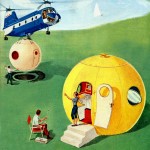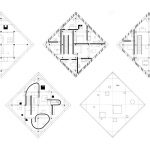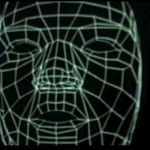Composer, inventor, older brother of James (read previous post ), one of the fathers of computer animation.
His most notable works include the animated title sequence of 1958 A.Hitchcock’s Vertigo, which he collaborated on with the graphic designer Saul Bass.
<iframe width=”800″ height=”600″ src=”//www.youtube.com/embed/pz46qS38OgM” frameborder=”0″ allowfullscreen></iframe>
He used mechanical animation devices in his early years. Then, during the late 50’s, he invented an analog computer by, firstly, converting the mechanism of a World War II M-5 Antiaircraft Gun Director, then augmenting it with an M-7 mechanism, creating a twelve-foot-high machine. Design templates were placed on three different layers of rotating tables and photographed by multiple-axis rotating cameras. Color was added during optical printing.
Whitney’s son, John, Jr., described the mechanism in 1970:
“I don’t know how many simultaneous motions can be happening at once. There must be at least five ways just to operate the shutter. The input shaft on the camera rotates at 180 rpm, which results in a photographing speed of 8 fps. That cycle time is constant, not variable, but we never shoot that fast. It takes about nine seconds to make one revolution. During this nine-second cycle the tables are spinning on their own axes while simultaneously revolving around another axis while moving horizontally across the range of the camera, which may itself be turning or zooming up and down. During this operation we can have the shutter open all the time, or just at the end for a second or two, or at the beginning, or for half of the time if we want to do slit-scanning“
(From Wikipedia)
By the 70’s he switched to faster digital machines, able to produce works such as 1975 Arabesque, characterized by psychedelic colour forms.
Some diverse harmonic caesura selected from the computer graphics material used in the film titled Arabesque :

He later invented an audio-visual compositional program called “Whitney-Reed RDTD (Radius-Differential Theta Differential)”.
Moondrum (1989 – 1995) was born in this period and explored mystical Native American themes.
Watch some examples of his work:
Catalog (1961)
Permutations (1966)
httpvh://www.youtube.com/watch?v=BzB31mD4NmA
Matrix II (1972) (Early computer graphics)
httpvh://www.youtube.com/watch?v=ZrKgyY5aDvA
Arabesque (1975)
httpvh://www.youtube.com/watch?v=w7h0ppnUQhE
Read more:
The John Whitney Biographical Site at SIGGRAPH.
John Withney computational periodics. (essay by Whitney in Artist and Computer, 1976)




The Power of Point!
The POWERPOINT!
Hi friend i you\’re Blog! The information is great keep it up.